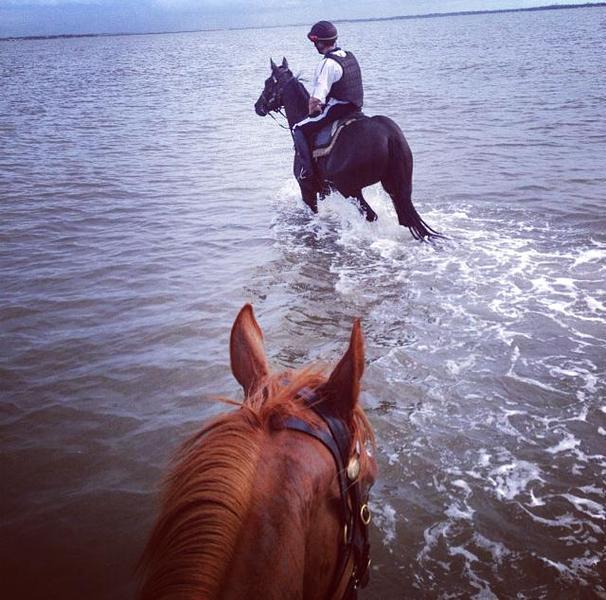A while back I was asked by an owner, what would be a typical day for his horse, whilst in training. As I answered it occurred to me that possibly other owners have wondered the same but never asked the question.
A typical day starts at 3.50am with the lights being turned on in the main barn and the outside yards. All of the horses in the barn (which are mostly colts and geldings) have their halters put on and they are tied up to the back of the box to wait patiently until it is their time to be ridden.
The feed and water buckets are removed and thoroughly scrubbed out and placed neatly stacked up outside of their box. The hay bag is filled and hung on the hook outside their stable.
One of the stable hands then comes in and administers their daily dose of ulcer prevention treatment. The winter rug is removed leaving only their cotton or woollen under rug. The next time that someone comes into their stable it is to saddle the horse up and put him on the automatic walker for a warm up.
The rider will then take the horse off the walker put on the bridle, mount the horse and head off to track work usually in pairs or groups of three. The walk from our stables to the Eagle Farm track takes approximately 10 to 15 minutes. The horse then works around the track at whatever pace Danny has specified to the rider.
After track work the horse walks back to the stable to be unsaddled in the tie up stall. The horse is then hosed down, towel dried and put on the walker for 5 minutes to dry off. During the time the horse has been out on the track working, his water bucket has been filled, his stable has been cleaned, lime has been sprinkled on the floor to neutralise odours and fresh sawdust has been added to his box.
The horse is once again tied up at the back of his box, his day rug is put on and he is given his hay bag. A stable hand will then come in and put the Equissage machine on his back for a 20 minute therapeutic muscle massage. At the same time he will have the ice boots (which look like fly fishing boots) applied to his front legs and filled with a 1kgs of ice per leg.
Once the Equissage and ice boots are removed the stable hand applies a mud/liniment poultice to the front legs from the knee down to the fetlock. Depending on whether the horse has an issue or whether the mud is just for prevention will determine if the legs are bandaged as well.
If the horse has any specific injuries he may need to be taken to the treatment stall for ultrasound therapy. The vet drops in every morning and Danny usually has a list of tasks (e.g. blood tests, trot up examinations, joint injections or general consultations). Almost as soon as the vet departs the farrier arrives and checks the whiteboard to see who needs shoeing or who is racing and needs new plates.
The horses then have a midday nap before the afternoon shift begins. Some are given time out in the day yards so that they can feel the winter sun on their backs. The afternoon shift starts at 2pm when the staff arrive. The horses are put on the automatic walker for approximately 20 minutes whilst their boxes are cleaned, their night feed and hay is put in and water buckets filled. The horses love their afternoon walk as they are free to kick up their heels and play with their buddies without the restraint of a rider or handler.
Some horses go to the pool of an afternoon weather permitting which includes a 20 minute walk to the pool a couple of quick laps and then a 20 minute walk back to the stables. Others go to the Nudgee beach which is a quick 10 minute float ride away. The trip to the beach is a great diversion from the routine for both the horses and the riders as it is very enjoyable to walk through the salt water on a sunny day.
The racehorse’s day concludes with the night rugs being put on and then it is time for rest before the next day begins and the routine starts all over. The only real change to this routine is Sunday’s when the horses get a sleep in and then spend 30 minutes on the walker in the morning and afternoon as they are not ridden at track work.
